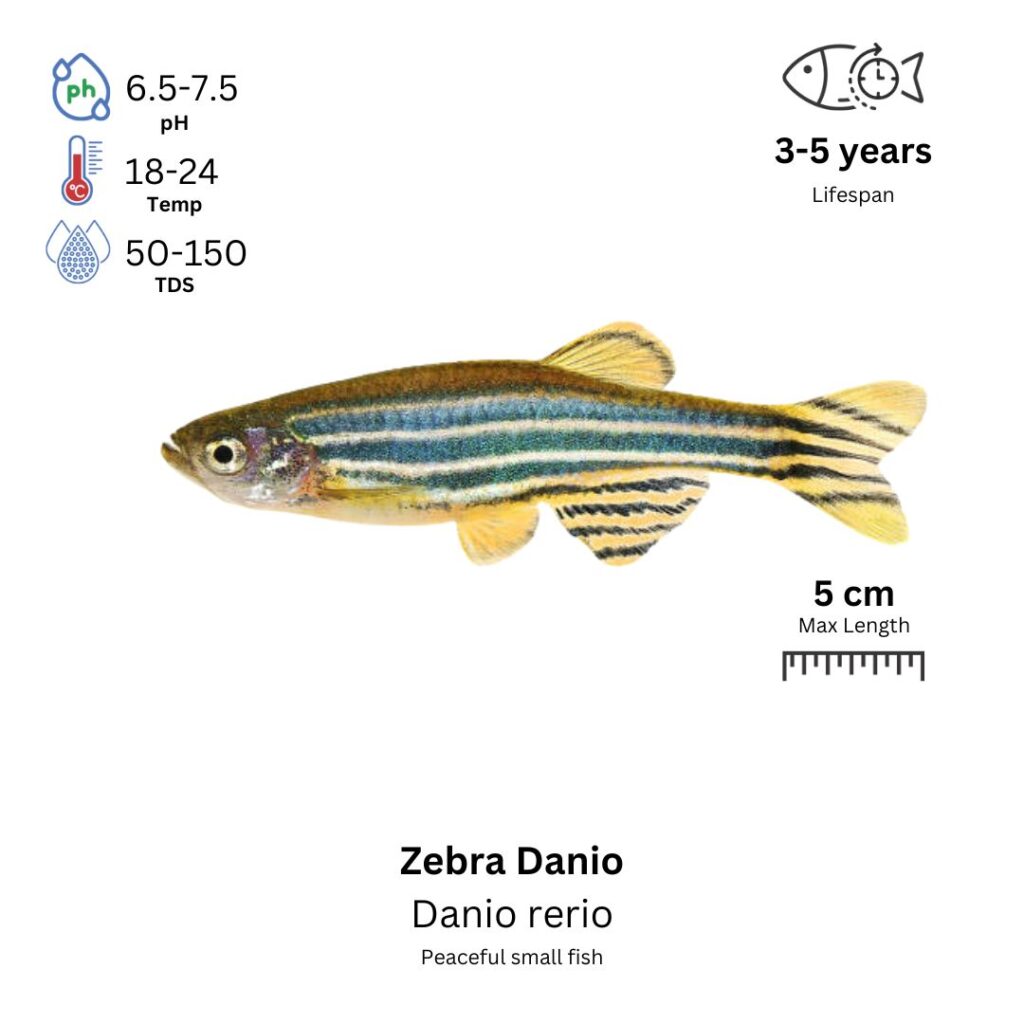Zebra Danio
Danio rerio

Description
The Zebra Danio is a small, active, and colorful fish known for its distinctive blue and silver striped pattern, resembling the stripes of a zebra. The body of the Zebra Danio is slender and streamlined, with alternating horizontal stripes that run from the head to the tail. These stripes are typically blue or silver, and the fish can come in various colors, including wild-type (natural) and selectively bred variants like gold, pink, or white. Zebra Danios are hardy, peaceful, and social fish that thrive in schools, often swimming energetically throughout the aquarium. They are quick and lively, making them a fun species to watch.
Habitat Origin
Native to the freshwater rivers and streams of South Asia, specifically India, Bangladesh, Nepal, and Myanmar. They are commonly found in slow-moving waters with dense vegetation and submerged structures. Zebra Danios are adaptable and resilient, capable of tolerating a variety of water conditions.
Aquarium
Ideal Number in Aquarium: At least 6 individuals, as they are schooling fish and feel more secure in groups.
Favorite Food

Zebra Danios are omnivores and will accept a variety of foods, including high-quality flake food, micro pellets, and live or frozen foods such as brine shrimp, daphnia, and bloodworms. They will also graze on algae and small plant matter in the tank. A varied diet ensures they maintain their vibrant colors and overall health.
Behavior:
Zebra Danios are peaceful and social fish that thrive in schools. They are active swimmers, often seen darting through the middle and upper regions of the tank. They are not aggressive and are ideal for community aquariums, making them a great choice for beginner aquarists. Their energetic and lively behavior makes them fun to watch as they swim quickly around the tank. Zebra Danios are generally calm but can display playful interactions with other fish of the same species.
Special Care:
Zebra Danios are hardy and adaptable, but they do best in a well-maintained tank with stable water conditions. They prefer a well-planted tank with plenty of hiding spots, but they also enjoy open swimming areas. Regular water changes and good filtration are important for maintaining a clean and stable environment. Zebra Danios are tolerant of a wide range of water conditions, but it’s best to keep their tank environment clean and properly oxygenated. They are not particularly sensitive to water quality, which makes them an excellent choice for beginners.
Compatibility with Other Fish:
Yes, Zebra Danios are ideal for community tanks with other small, peaceful species. They can be kept with tetras, rasboras, small catfish, and peaceful shrimp. They should not be housed with large or aggressive species, as they may become stressed or become prey. Their lively, peaceful nature allows them to coexist well with a variety of other species that occupy different levels of the tank.
Breeding Setup
Although Zebra Danios can spawn in community tanks, using a separate 20-liter (5-gallon) breeding tank is strongly recommended to provide better control over water conditions and protect the eggs and fry from predation. Maintain pH between 6.5 and 7.5, temperature at 24–28°C (75–82°F), and water hardness of 5–12 dGH. Use a gentle sponge or internal filter to avoid creating strong currents that may disturb spawning. A bare-bottom tank or one with fine gravel helps with egg collection, while live plants like Java moss and Hornwort or spawning mats offer suitable surfaces for egg attachment.
Conditioning for Breeding
To condition Zebra Danios for spawning, feed them a varied and protein-rich diet. Offer high-quality flakes, live foods (brine shrimp, daphnia), and frozen bloodworms to ensure optimal health and increase breeding readiness. Perform 25% weekly water changes to maintain clean, oxygenated water. Good nutrition and stable water conditions significantly boost the likelihood of successful breeding events.
Spawning Process
Zebra Danios are egg scatterers and usually spawn in the early morning or evening. During courtship, males chase females, prompting the females to release eggs, which then stick to plants or tank surfaces. A single female may lay up to 100 eggs per session. To protect the eggs from being eaten, remove the adult fish immediately after spawning. Their instinctive egg-predation behavior can wipe out a spawn if not managed carefully.
Fry Care
Eggs hatch in about 24–36 hours, after which the fry remain attached to surfaces while absorbing their yolk sacs. When they begin free-swimming, start feeding them infusoria, liquid fry food, or baby brine shrimp. Gradually introduce finely crushed flakes as they grow. Maintain excellent water quality with daily 10–15% water changes, and keep water temperature within 24–28°C. Regularly monitor for harmful ammonia or nitrite levels to support healthy fry development.
Key Considerations
Zebra Danios reach breeding maturity around 3 to 4 months, though slightly older fish often breed more successfully. Males are typically smaller, more slender, and exhibit brighter coloration, while females are larger and more rounded, particularly when carrying eggs. Although hardy, Zebra Danios can become stressed by sudden changes in temperature, pH, or overcrowding. A calm and consistent environment is essential to foster natural breeding behavior and raise healthy fry.
